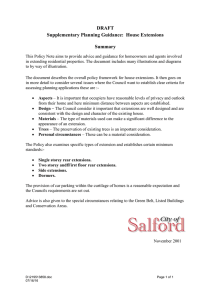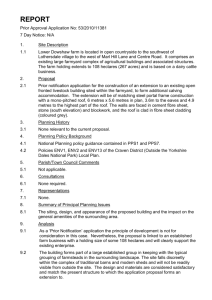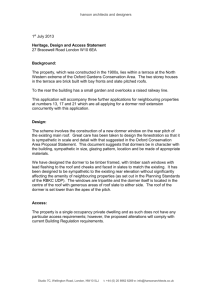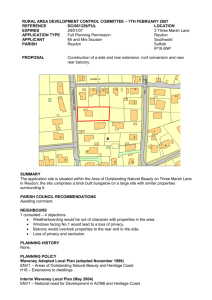a guide for extending a detached or semi
advertisement
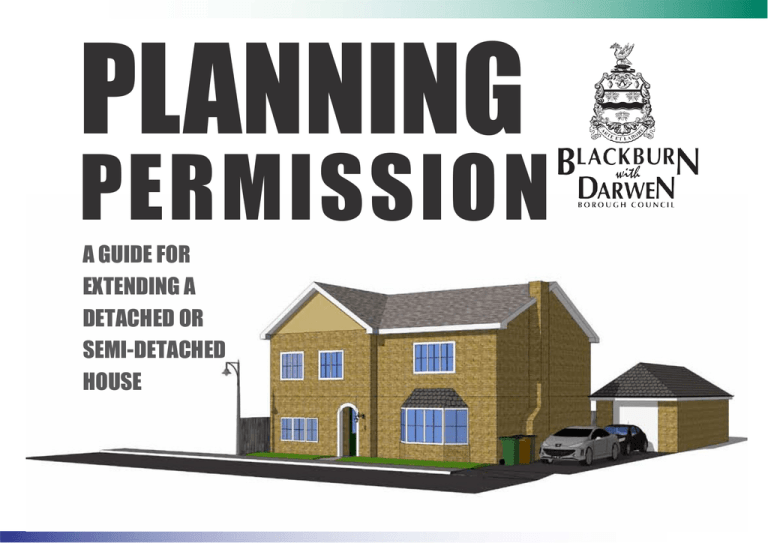
PLANNING PERMISSION A GUIDE FOR EXTENDING A DETACHED OR SEMI-DETACHED HOUSE Introduction Foreword by Councilor Dave Smith - Chair of the Planning & Highways Committee. Planning Permissions B Owners of semi-detached & detached homes often find it difficult to know how best to extend their homes to provide much needed space for growing and extending families. This visual guide is intended to show how a semi-detached/detached property can be extended to add habitable space whilst maintaining the right to light and privacy of adjoining neighbours. The guide firstly explains that there are a number of ways to extend a semi-detached/detached property without the need for planning permission, and the Council would encourage homeowners to do this. Where an owner wants to extend beyond the limits of their Permitted Development Rights then planning permission will be required. The guide goes on to provide some ideas and options on extensions to show what would, and what would not, be appropriate. Councillor Dave Smith Councillor Jim Smith 1. PLANNING PERMISSION IS NOT USUALLY REQUIRED FOR THE FOLLOWING: Rear Dormer • • • • • Maximum additional volume of 50 cubic metres Positioned below the ridge Set back at least 20cm from the eaves Materials must match the existing roof, e.g. the dormer must be clad with tiles or slates No verandas, balconies or raised platforms 20cm Side Dormer The same requirements as the Rear Dormer apply, plus: Windows must be non-opening unless the opening is at least 1.7 metres above the fl of the room Roof Windows The insertion of a roof window generally does not require planning permission if it does not project more than 15cm beyond the roof slope, or higher than the ridge. However, if additional volume is created it may be treated as an extension and seperate rules will apply. 15cm Always Check! Always check with the Council because there may be a restriction on the property. 2. PLANNING PERMISSION IS NOT USUALLY REQUIRED FOR THE FOLLOWING: Single Storey Rear Extensions Planning Permissions BwD • Projects no more than 4 metres beyond the rear wall of the original house, • Materials should be of similar appearance to the existing dwelling • Must not exceed 50% of the total garden area (including the front garden if there is one) • Must not include a veranda, balcony or raised platform • Maximum height 4 metres • Must not exceed the height of the existing dwelling • Maximum eaves height 3 metres if within 2 metres of the boundary. • The eaves height must not exceed the existing eaves height Always Check! Eaves the point where the wall meets the roof Always check with the Council because there may be a restriction on the property. If this is the case Planning Permission will be required. 3. PLANNING PERMISSION IS NOT USUALLY REQUIRED FOR THE FOLLOWING: Single Storey Side Extensions Planning Permissions BwD • Must not extend beyond a wall which fronts a highway • Must not wrap around the rear of the original house • Must not exceed 50% of the original garden area • Maximum eaves height 3 metres if within 2 metres of the boundary • Must not exceed the height of the existing dwelling • Maximum height 4 metres • The eaves must not exceed the existing eaves height • Must not have a width greater than half the width of the original house • Must not include a veranda, balcony or raised platform • Materials should be of similar appearance to the existing dwelling Always Check! Always check with the Council because there may be a restriction on the property. If this is the case Planning Permission will be required. For example, if the property is in a Conservation Area planning permission will be required for a side extension. 4. PLANNING PERMISSION IS NOT USUALLY REQUIRED FOR THE FOLLOWING: Two Storey Rear Extensions • Must not exceed 50% of the original garden area, including any previous extensions • Must not exceed the height of the existing dwelling • The eaves height must not exceed the existing eaves height • Projects no more than 3 metres beyond the rear wall of the original house, and must not be within 7 metres of the rear garden boundary Planning Permissions BwD • Must not project beyond the side of the original house • Must not be within 2 metres of any boundary • Must not include a veranda, balcony or raised platform • Materials should be of similar appearance to the existing dwelling Always Check! Always check with the Council because there maybe a restriction on the property. If this is the case Planning Permission will be required. 5. PLANNING PERMISSION IS NOT USUALLY REQUIRED FOR THE FOLLOWING: Porch (outside any external door of a house Planning Permissions BwD • The ground area (measured externally) of the structure must not exceed 3 square metres • Must not exceed 3 metres height • Must not be within 2 metres of any boundary with the highway or pavement New or Replacement Front Driveway (over 5 square metres) • Must be made of porous materials which allows rainwater to soak through, or rainwater run-off must be directed to a porous area within the site and not onto the road Single Storey outbuilding • The total ground area covered by buildings must not exceed 50% of the total area, excluding the original house • No part of the building must be situated on land which is forward of the front wall of the house • Must not exceed 4 metres height (dual-pitched roof), 2.5 metres height if it is within2 metres of the boundary, or 3 metres height in any other case • Eaves height must not exceed 2.5 metres • Must not include a veranda, balcony or raised platform Always Check! Always check with the Council because there may be a restriction on the property. If this is the case Planning Permission will be required. 6. PLANNING PERMISSION IS NOT USUALLY REQUIRED FOR THE FOLLOWING: Renewable energy Planning Permissions BwD The planning system allows for certain types of renewable energy developments on houses to proceed without needing to apply for planning permission as long as certain conditions are met. These include: • solar panels • ground source heat pump • water source heat pump • flue for a biomass heating system or a combined heat and power system • air source heat pump • wind turbine not to exceed 15m in height(detached houses only) Always Check! Please see the individual technology fact sheets for further information via the Council website. Please note: if the building is listed or within a conservation area additional restrictions will apply. To avoid confusion, it is always recommended that you contact the council’s Planning Department before installing any renewable energy technology to confirm whether or not planning permission is required. 7. WHEN PLANNING PERMISSION IS NEEDED All extensions Planning Permissions BwD The 45 Degree Rule ELEVATION VIEW The council applies the 45 degree rule as an indicator when assessing proposed extensions, to ensure that a satisfactory relationship is maintained between existing buildings and proposed extensions. Extensions are measured at an angle of 45 degrees from the midpoint of the closest window in a habitable room of a neighbouring property. If the extension lies within the 45 degree angle when measured horizontally or vertically, an unacceptable loss of daylight and dominance may be caused and planning permission may be refused. In the case where the neighbouring window is a patio door, the 45 degree angle is measured from 1.6 metres above the ground on the centre line of the window. 45o PLAN VIEW 4 5 o ) Bathroom (non-habitable 450 Habitable rooms: living rooms, dining rooms, kitchen/diner and bedrooms 45 0 8. WHEN PLANNING PERMISSION IS NEEDED All extensions Planning Permissions BwD Parking Requirements Overdevelopment Adequate parking space must be retained within the site in accordance with the Council’s adopted Parking Standards. If new parking spaces are to be created in the front garden area, at least one third of the garden should be kept as a planted garden rather than hard surfacing. For example 2-3no. bedrooms will require 2 spaces, and 4no. bedrooms will require 3 spaces. The car parking standards are available on the Council’s planning website. Extensions should ensure that adequate garden space is left open for the storage of bins, maintenance, clothes drying and to safeguard the health of residents in respect of light and air. Seperation Distances A distance of no less than 21 metres must be maintained between facing windows of habitable rooms, and a distance of no less than 13.5 metres must be maintained between a habitable room window and a blank gable or wall with only windows to non-habitable rooms. 9. WHEN PLANNING PERMISSION IS NEEDED Front Dormer Planning Permissions BwD Do Do not the following pages aim to show examples of alterations which require planning permission and how best to achieve a planning approval. • At least two thirds of the original roof plane is retained • Matching Materials • No larger than existing windows • Pitched roof rather than flat roof • Leave 1 metre distance to the party walls • Do not exceed the ridge height of the original roof • Too big • Materials don’t match • Flat roof is a poor design • Windows too big • Box-shaped and too bulky Always Check! If the property is within a Conservation Area, or there are no other front dormers on the street, it is unlikely that planning permission would be granted. WHEN PLANNING PERMISSION IS NEEDED Rear Dormer • • Planning Permissions BwD Dormer covering all of the roof area and above the ridge. Materials not matching the original roof • • • Dormer roof set lower than the original ridge height. Set in from both side boundaries. Clad in materials to match the original roof. If the property is in a Conservation Area, dormer extensions are unlikely to receive planning permission due to their impact on the character of the historic area. 11. WHEN PLANNING PERMISSION IS NEEDED ground Floor Rear extensions Do Planning Permissions BwD • Include a sloping roof • Prevent loss of daylight or overshadowing of neighbouring houses • Retain some rear garden / yard space for bins, maintenance and clothes drying. • Consider 45 o rule (see Page 8) Do not • Flat Roof • Site where adjacent properties have no extensions • Project extension full length of the garden • Overshadow the next door rear window NOT ALL DEVELOPMENTS ARE THE SAME The following will have a bearing on whether extensions will be allowed. • Number, location and size of extensions at adjoining properties. • Position of the property in relation to the sun. • Different ground level e.g Sloping site. • Location of living room and bedroom windows in the next door property. • Design of the extension and harmony with the original house 12. WHEN PLANNING PERMISSION IS NEEDED Two Storey Rear Extensions Planning Permissions BwD Two storey rear extensions usually require planning permission. In many cases, planning applications are rejected because a two storey extension close to neighbouring houses can significantly harm the living conditions of neighbours through overshadowing, loss of privacy, or dominance. The following pages show five situations where two storey rear extensions may be acceptable, on semi-detached houses. 1. Sloping Site Overshadowing and dominance can be minimised if the site of the extension is lower than the immediate neighbour. 13. WHEN PLANNING PERMISSION IS NEEDED Two Storey Rear Extensions Planning Permissions BwD 2. Joint extension across two houses Overshadowing and dominance can be avoided if two houses build a joint extension at the same time. 14. WHEN PLANNING PERMISSION IS NEEDED Two Storey Rear Extensions Planning Permissions BwD Bathroom extension Hallway 3. Nearest neighbouring windows are for non-habitable rooms Overshadowing or dominance of a non-habitable room (such as bathroom or hallway) in some cases does not cause significant harm to the living conditions of neighbours and may be acceptable. Please refer to the 45 degree rule which is explained on Page 8. 15. WHEN PLANNING PERMISSI0N IS NEEDED Two Storey Rear Extensions Planning Permissions BwD 4. Built next to an existing extension at an adjoining house Overshadowing and dominance can be minimised if the extension is built next to an existing extension at a neighbour’s house. (Subject to the adjacent window serving a non-habitable room) Please refer to the 45 degree rule which is explained on Page 8. 16. WHEN PLANNING PERMISSION IS NEEDED Two Storey Rear Extensions Planning Permissions BwD 5. Outer Edge of Building Overshadowing and dominance can be minimised if the extension is built at the outer edge of the building, away from the nearest neighbour. 17. WHEN PLANNING PERMISSION IS NEEDED Side extensions Do Planning Permissions BwD Do not • Match the roof shape of the original house • Refer to the 45 degree rule (see page 8) • Do not project beyond the original front of the house • Have a lower ridge than original roof • Keep a gap of at least 1 metre between properties • Match materials, window styles and positions • For two-storey side extensions, the first floor should set be back from the front of the house by at least 1.5 m and etres the eaves level should match the existing eaves level •• Flat Roof Flat Roof Create aa terracing •• Create terracingeffect effect • Project beyond the front build line On corner plots, do project •• Project beyond thenot front buildbeyond line the side build line • On corner plots, do not project beyond the side build line 7 Two storey extensions up to the side boundary and flush with the original front wall remove the visual separation between the buildings and create the impression of a continuous terrace The preferred approach is to maintain a gap between properties: this is the best way to prevent a terracing effect. other options may also be available for extending or gaining extra living space. 18. WHEN PLANNING PERMISSION IS NEEDED: Porches Planning Permissions BwD Conservatories • Match the roof shape of the original house • Match the style and the materials of the house • • In keeping with the appearance of the street and does not detract from the character of the street Dwarf walls should be included with materials to match the house • Refer to the 45 degree rule and separation distances described on page 8. • Where a conservatory is adjacent to a boundary with a neighbour, an acceptable degree of privacy should be maintained by means of a solid side, obscure glazing or screening by a fence or wall on the side facing the neighbour. 19 . GREATER FLEXIBILITY RELATING TO EXTENSIONS AND THE PRIOR APPROVAL PROCESS Class A Single Storey rear extensions: You may extend beyond the rear wall of the original dwellinghouse up to 8 metres (detached dwellinghouse), or 6 metres (semidetached dwellinghouse) subject to the following: It must not exceed 4 metres in height The enlarged part of the dwellinghouse would be within 2 metres of the boundary of the curtilage of the dwellinghouse, and the height of the eaves of the enlarged part would not exceed 3 metres. Materials must match the existing dwellinghouse You must submit your notification to the local planning authority and include further information regarding the proposed extension to enable the authority to determine the application. The authority has 42 days from receipt to notify you whether the proposed development would be permitted development. The new regulations are only temporary expiring on the 30th May 2016. All developments must be completed before this date. Further guidance is available on the Council’s planning web page. WHAT TO DO NEXT… Planning Permissions BwD Before starting any work you are advised to check to see if planning permission is required. If planning permission is required, we can offer you professional advice before you formally submit a planning application. This is a discretionary and chargeable service offered by the Council. Having early constructive discussions will help you save time, avoid wasted expense and frustration over any delays in the processing of your planning application. Pre-application enquiry forms and scale of fees can be downloaded from the planning pages of the council’s website www.blackburn.gov.uk/planning. APPLY If planning permission is required, you can complete and submit your application yourself or you can employ an agent to draw your plans and act as your representative when dealing with the planning department. The Council does not recommend particular agents however a list of planning agents can be found on the Royal Town Planning Institute’s website: www.rtpi.org.uk; and a list of architects can be found on the Royal Institute of British Architecture website: www.architecture.com. Planning application forms and guidance notes can be downloaded from the planning section of the council’s website www.blackburn.gov.uk/planning, which provides detailed guidance on the supporting information and scale of fees. It is important to provide as much relevant information as you can to avoid any unnecessary delay in the progress of your application. If in doubt please contact us. When a planning application is submitted: • We will write to your immediate neighbours explaining your proposal to ask for their comments • In some cases we may put up a site notice or advertise the application in the press. e.g. in Conservation Areas and/or Listed Buildings • We will not make a decision until we have allowed at least 21 days for comments to be made. We will take account of all comments received prior to a decision being made. • The planning case officer will assess the application against the relevant legislation and policies, taking into account any comments received from interested parties. The case officer will then make a recommendation as to whether it should be approved or refused. • The final decision will be made by either the Director of Regeneration or the Planning & Highways Committee within a target timescale of 8 weeks. • The decision notice will be posted to you (and your agent if you have appointed one). DECISION There are two types of decision that can be made: Permits or Refuses. In most cases, planning permissions are subject to conditions that are listed on the decision notice. For example, you must commence work within 3 years of the date of the permission. If your application is refused, a revised application of the same character and description can usually be submitted within 12 months of the refusal date without requiring a further planning fee. Alternatively, you may wish to appeal to the Planning Inspectorate against the Councils Refusal. Please note: You are advised to contact Building Control – their separate permissions may be required for certain internal and external alterations. Contact (01254) 505022 or email: bc@penninelancsplace.org Blackburn with Darwen Borough Council Development Management Team Lower Ground Floor Old Town Hall King William Street Blackburn BB1 7DY www.blackburn.gov.uk 20.
